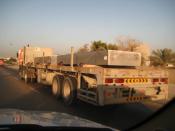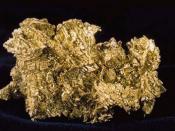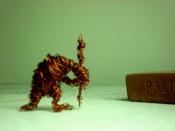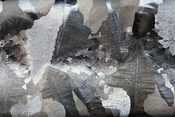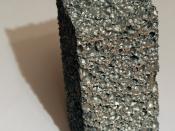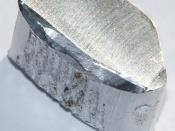1. The Purpose Of The Test: - 44mm Galvanised - 57mm Aluminium - 67mm Copper - 7mm Galvanised ÃÂ÷ I will be measuring the deflection of the 4 types of materials and seeing how much it would hold on it with weights. And also I will be scuffing, piling, creasing, scratching, indentation, and seeing the changes in the colour and flexibility.
ÃÂ÷ The reason why we are preforming the test is to learn the strength of the materials and toughness of the materials.
2.The Materials Used In Testing: -44mm Galvanised -Aluminium -Copper -7mm Galvanised Galvanised Steel Rusts easily in damp air and gradually wears away, or corrodes. To prevent this corrosion, it may be coated with a layer of another metal that does not corrode. Zinc is one such metal. Coating steel with zinc is called Galvanising. It is used for coating such things as wire-netting, buckets, storage tanks, and structures.
Steel can also be Galvanised in other ways. One way is to spray the steel with molten zinc. Another way is to heat it in a container with zinc "ÃÂdust'.
Copper Copper is one of our most useful metals. It is also one of the few metals that can be found in metal form in nature. But most Copper comes from ores mined deep in the ground.
Copper has an Attractive reddish-orange colour. It can easily be beating into thin sheets and complicated shapes and drawn into wire. It also does not corrode (wear away) quickly when exposed to the air.
Aluminium Aluminium is a particularly valuable metal because it is so light. It is much lighter than steel, and some of its alloys are as strong as steel. Aluminium and its alloys are therefore widely used in railway carriages, ships, and aeroplanes where lightness and strength are needed. Also Aluminium does not corrode (wear away) when exposed to the air.
3.A Description Of The Test Procedure: ÃÂ÷ My partner Rikki and I got all of our 4 metals and ruler and a clamp a piece of wood and some weights. We were using our first piece of metal and then set it 130mm over the edge of the table. We clamped the wood down by putting the piece of wood on top of the metal near the edge of the table and then put the clamp on the top of wood and under the table. And then we put a half kg weight on the top of it and if it didn't fall off we added more until it cant take no more weights. Then we measured how far down it deflected from the ground.
4.A Record Of The Observations And Results Of The Test ÃÂ÷ In this test we saw that the 7mm galvanise held the most weights therefore it is the strongest and the aluminium held the least and it was the weakest. The 67mm Copper was very weak aswell but it still held out 2kg, 1kg more then the Aluminium.
1 kg 2kg 3 kg 4kg 4ÃÂý kg .7mm Galvanise 806mm 805mm 804mm 803mm 799mm . 67mm Copper 805mm 799mm - - - .44mm Galvanise 799mm - - - - .57mm Aluminium 801mm - - - - ÃÂ÷ In this test we found out that 7mm Galvanise is once again the strongest and the toughest when it comes to scratching, centre punch, cutting and bending, but when it comes to heating it burns a hole through it. The Weakest was the Aluminium it was easy to scratch, centre punch, cut, bend and also heating it would melt it. The Copper was the strongest in heating because all it did was change colour and the 44mm Galvanise would also change colour but would burn a hole though it as well.
Scratching Centre punch Cutting Bending Heating .7mm Galvanise Hard 3 Hits Very Hard Very Hard Burns .67mm Copper Easy 2 Hits Hard Easy Changes Colour .44mm Galvanise Easy 1 Hit Easily Easy Easy Burns, Changes Colour to Green .57mm Aluminium Easy 1 Hit Easily Very Easy Easy Burns Through
